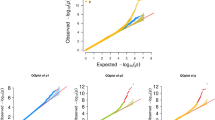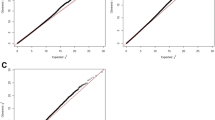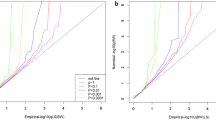Abstract
Summary
Bone mineral density (BMD) is an essential predictor of osteoporosis and fracture. We conducted a genome-wide trajectory analysis of BMD and analyzed the BMD change.
Purpose
This study aimed to identify the genetic architecture and potential biomarkers of BMD.
Methods
Our analysis included 141,261 white participants from the UK Biobank with heel BMD phenotype data. We used a genome-wide trajectory analysis tool, TrajGWAS, to conduct a genome-wide association study (GWAS) of BMD. Then, we validated our findings in previously reported BMD genetic associations and performed replication analysis in the Asian participants. Finally, gene-set enrichment analysis (GSEA) of the identified candidate genes was conducted using the FUMA platform.
Results
A total of 52 genes associated with BMD trajectory mean were identified, of which the top three significant genes were WNT16 (P = 1.31 × 10−126), FAM3C (P = 4.18 × 10−108), and CPED1 (P = 8.48 × 10−106). In addition, 114 genes associated with BMD within-subject variability were also identified, such as AC092079.1 (P = 2.72 × 10−13) and RGS7 (P = 4.72 × 10−10). The associations for these candidate genes were confirmed in the previous GWASs and replicated successfully in the Asian participants. GSEA results of BMD change identified multiple GO terms related to skeletal development, such as SKELETAL SYSTEM DEVELOPMENT (Padjusted = 2.45 × 10−3) and REGULATION OF OSSIFICATION (Padjusted = 2.45 × 10−3). KEGG enrichment analysis showed that these genes were mainly enriched in WNT SIGNALING PATHWAY.
Conclusions
Our findings indicated that the CPED1-WNT16-FAM3C locus plays a significant role in BMD mean trajectories and identified several novel candidate genes contributing to BMD within-subject variability, facilitating the understanding of the genetic architecture of BMD.



Similar content being viewed by others
Data availability
The UK Biobank data are available through the UK Biobank Access Management System (https://www.ukbiobank.ac.uk/). We will return the derived data fields following UK Biobank policy; in due course, they will be available through the UK Biobank Access Management System.
References
Kanis JA (1997) Diagnosis of osteoporosis. Osteoporos Int 7(3):108–116. https://doi.org/10.1007/BF03194355
Bonjour JP, Theintz G, Law F, Slosman D, Rizzoli R (1994) Peak bone mass. Osteoporosis Int 4(1):S7–S13. https://doi.org/10.1007/BF01623429
Farr JN, Khosla S (2015) Skeletal changes through the lifespan–from growth to senescence. Nat Rev Endocrinol 11(9):513–21. https://doi.org/10.1038/nrendo.2015.89
Richards JB, Zheng H-F, Spector TD (2012) Genetics of osteoporosis from genome-wide association studies: advances and challenges. Nat Rev Genet 13(8):576–588. https://doi.org/10.1038/nrg3228
Kanis JA, Johnell O, Oden A, Johansson H, McCloskey E (2008) FRAX and the assessment of fracture probability in men and women from the UK. Osteoporos Int 19(4):385–397. https://doi.org/10.1007/s00198-007-0543-5
Arden NK, Baker J, Hogg C, Baan K, Spector TD (1996) The heritability of bone mineral density, ultrasound of the calcaneus and hip axis length: a study of postmenopausal twins. J Bone Miner Res 11(4):530–534. https://doi.org/10.1002/jbmr.5650110414
Howard GM, Nguyen TV, Harris M, Kelly PJ, Eisman JA (1998) Genetic and environmental contributions to the association between quantitative ultrasound and bone mineral density measurements: a twin study. J Bone Mineral Res 13(8):1318–1327. https://doi.org/10.1359/jbmr.1998.13.8.1318
Hunter DJ, de Lange M, Andrew T, Snieder H, MacGregor AJ, Spector TD (2001) genetic variation in bone mineral density and calcaneal ultrasound: a study of the influence of menopause using female twins. Osteoporos Int 12(5):406–411. https://doi.org/10.1007/s001980170110
Lee M, Czerwinski SA, Choh AC et al (2006) Unique and common genetic effects between bone mineral density and calcaneal quantitative ultrasound measures: the Fels Longitudinal Study. Osteoporos Int 17(6):865–871. https://doi.org/10.1007/s00198-006-0075-4
Zhu X, Bai W, Zheng H (2021) Twelve years of GWAS discoveries for osteoporosis and related traits: advances, challenges and applications. Bone Res 9(1):23. https://doi.org/10.1038/s41413-021-00143-3
Kemp JP, Morris JA, Medina-Gomez C et al (2017) Identification of 153 new loci associated with heel bone mineral density and functional involvement of GPC6 in osteoporosis. Nat Genet 49(10):1468–1475. https://doi.org/10.1038/ng.3949
Morris JA, Kemp JP, Youlten SE et al (2019) An atlas of genetic influences on osteoporosis in humans and mice. Nat Genet 51(2):258–266. https://doi.org/10.1038/s41588-018-0302-x
Justice AE, Howard AG, Chittoor G et al (2016) Genome-wide association of trajectories of systolic blood pressure change. BMC Proc 10(7):56. https://doi.org/10.1186/s12919-016-0050-9
Couto Alves A, De Silva NMG, Karhunen V et al (2019) GWAS on longitudinal growth traits reveals different genetic factors influencing infant, child, and adult BMI. Sci Adv 5(9):eaaw3095. https://doi.org/10.1126/sciadv.aaw3095
Goldstein JA, Weinstock JS, Bastarache LA et al (2020) LabWAS: novel findings and study design recommendations from a meta-analysis of clinical labs in two independent biobanks. PLOS Genet 16(11):e1009077. https://doi.org/10.1371/journal.pgen.1009077
Henyš P, Vořechovský M, Kuchař M, Heinemann A, Kopal J, Ondruschka B, Hammer N (2021) Bone mineral density modeling via random field: normality, stationarity, sex and age dependence. Comput Methods Programs Biomed 210:106353. https://doi.org/10.1016/j.cmpb.2021.106353
Rothwell PM, Howard SC, Dolan E et al (2010) Prognostic significance of visit-to-visit variability, maximum systolic blood pressure, and episodic hypertension. The Lancet 375(9718):895–905. https://doi.org/10.1016/S0140-6736(10)60308-X
Ivarsdottir EV, Steinthorsdottir V, Daneshpour MS et al (2017) Effect of sequence variants on variance in glucose levels predicts type 2 diabetes risk and accounts for heritability. Nat Genet 49(9):1398–1402. https://doi.org/10.1038/ng.3928
Ratti C, Vulcano E, Canton G, Marano M, Murena L, Cherubino P (2013) Factors affecting bone strength other than osteoporosis. Aging Clin Exp Res 25(1):9–11. https://doi.org/10.1007/s40520-013-0098-6
Pitukcheewanont P, Austin J, Chen P, Punyasavatsut N (2013) Bone health in children and adolescents: risk factors for low bone density. Pediatr Endocrinol rev : PER 10(3):318–335
Ko S, German CA, Jensen A et al (2022) GWAS of longitudinal trajectories at biobank scale. Am J Hum Genet 109(3):433–445. https://doi.org/10.1016/j.ajhg.2022.01.018
Bycroft C, Freeman C, Petkova D et al (2018) The UK Biobank resource with deep phenotyping and genomic data. Nature 562(7726):203–209. https://doi.org/10.1038/s41586-018-0579-z
German CA, Sinsheimer JS, Zhou J, Zhou H (2022) WiSER: robust and scalable estimation and inference of within-subject variances from intensive longitudinal data. Biometrics 78(4):1313–1327. https://doi.org/10.1111/biom.13506
DayemUllah AZ, Lemoine NR, Chelala C (2013) A practical guide for the functional annotation of genetic variations using SNPnexus. Brief Bioinform 14(4):437–447. https://doi.org/10.1093/bib/bbt004
Watanabe K, Taskesen E, van Bochoven A, Posthuma D (2017) Functional mapping and annotation of genetic associations with FUMA. Nat Commun 8(1):1826. https://doi.org/10.1038/s41467-017-01261-5
Kutmon M, Riutta A, Nunes N et al (2016) WikiPathways: capturing the full diversity of pathway knowledge. Nucleic Acids Res 44(D1):D488–D494. https://doi.org/10.1093/nar/gkv1024
Liberzon A, Subramanian A, Pinchback R, Thorvaldsdóttir H, Tamayo P, Mesirov JP (2011) Molecular signatures database (MSigDB) 3.0. Bioinformatics 27(12):1739–40. https://doi.org/10.1093/bioinformatics/btr260
Estrada K, Styrkarsdottir U, Evangelou E et al (2012) Genome-wide meta-analysis identifies 56 bone mineral density loci and reveals 14 loci associated with risk of fracture. Nat Genet 44(5):491–501. https://doi.org/10.1038/ng.2249
Chesi A, Mitchell JA, Kalkwarf HJ et al (2015) A trans-ethnic genome-wide association study identifies gender-specific loci influencing pediatric aBMD and BMC at the distal radius. Hum Mol Genet 24(17):5053–5059. https://doi.org/10.1093/hmg/ddv210
Rivadeneira F, Styrkársdottir U, Estrada K et al (2009) Twenty bone-mineral-density loci identified by large-scale meta-analysis of genome-wide association studies. Nat Genet 41(11):1199–1206. https://doi.org/10.1038/ng.446
Medina-Gomez C, Kemp JP, Estrada K et al (2012) Meta-analysis of genome-wide scans for total body BMD in children and adults reveals allelic heterogeneity and age-specific effects at the WNT16 locus. PLoS Genet 8(7):e1002718. https://doi.org/10.1371/journal.pgen.1002718
Zheng HF, Tobias JH, Duncan E et al (2012) WNT16 influences bone mineral density, cortical bone thickness, bone strength, and osteoporotic fracture risk. PLoS Genet 8(7):e1002745. https://doi.org/10.1371/journal.pgen.1002745
Määttä JA, Bendre A, Laanti M et al (2016) Fam3c modulates osteogenic cell differentiation and affects bone volume and cortical bone mineral density. Bonekey Rep 5:787. https://doi.org/10.1038/bonekey.2016.14
Kemp JP, Medina-Gomez C, Estrada K et al (2014) Phenotypic dissection of bone mineral density reveals skeletal site specificity and facilitates the identification of novel loci in the genetic regulation of bone mass attainment. PLoS Genet 10(6):e1004423. https://doi.org/10.1371/journal.pgen.1004423
Hendriks-Balk MC, Peters SLM, Michel MC, Alewijnse AE (2008) Regulation of G protein-coupled receptor signalling: focus on the cardiovascular system and regulator of G protein signalling proteins. Eur J Pharmacol 585(2):278–291. https://doi.org/10.1016/j.ejphar.2008.02.088
Aissani B, Wiener HW, Zhang K (2016) Fine Mapping of the Body Fat QTL on Human Chromosome 1q43. PLoS One 11(4):e0153794. https://doi.org/10.1371/journal.pone.0153794
Shim H, Wang CT, Chen YL et al (2012) Defective retinal depolarizing bipolar cells in regulators of G protein signaling (RGS) 7 and 11 double null mice. J Biol Chem 287(18):14873–14879. https://doi.org/10.1074/jbc.M112.345751
Comuzzie AG, Cole SA, Laston SL, Voruganti VS, Haack K, Gibbs RA, Butte NF (2012) Novel genetic loci identified for the pathophysiology of childhood obesity in the Hispanic population. PLoS One 7(12):e51954. https://doi.org/10.1371/journal.pone.0051954
Tucker KL, Hannan MT, Qiao N, Jacques PF, Selhub J, Cupples LA, Kiel DP (2005) Low plasma vitamin B12 is associated with lower BMD: the Framingham osteoporosis study. J Bone Miner Res 20(1):152–8. https://doi.org/10.1359/jbmr.041018
De Martinis M, Sirufo MM, Nocelli C, FontanellaL L (2020) Ginaldi Hyperhomocysteinemia is associated with inflammation, bone resorption, vitamin B12 and folate deficiency and MTHFR C677T polymorphism in postmenopausal women with decreased bone mineral density. Int J Environ Res Public Health 17(12):4260
Laporte J, Hu LJ, Kretz C et al (1996) A gene mutated in X–linked myotubular myopathy defines a new putative tyrosine phosphatase family conserved in yeast. Nat Genet 13(2):175–182. https://doi.org/10.1038/ng0696-175
Nandurkar HH, Layton M, Laporte J et al (2003) Identification of myotubularin as the lipid phosphatase catalytic subunit associated with the 3-phosphatase adapter protein, 3-PAP. Proc Natl Acad Sci U S A 100(15):8660–8665. https://doi.org/10.1073/pnas.1033097100
Gupta VA, Hnia K, Smith LL et al (2013) Loss of catalytically inactive lipid phosphatase myotubularin-related protein 12 impairs myotubularin stability and promotes centronuclear myopathy in zebrafish. PLoS Genet 9(6):e1003583. https://doi.org/10.1371/journal.pgen.1003583
Cahill PJ, Rinella AS, Bielski RJ (2007) Orthopaedic complications of myotubular myopathy. J Pediatr Orthop 27(1):98–103
Pei YF, Liu YZ, Yang XL, Zhang H, Feng GJ, Wei XT, Zhang L (2020) The genetic architecture of appendicular lean mass characterized by association analysis in the UK Biobank study. Commun Biol 3(1):608. https://doi.org/10.1038/s42003-020-01334-0
Zhu Z, Guo Y, Shi H et al (2020) Shared genetic and experimental links between obesity-related traits and asthma subtypes in UK Biobank. J Allergy Clin Immunol 145(2):537–549. https://doi.org/10.1016/j.jaci.2019.09.035
Miyakoshi N, Hongo M, Mizutani Y, Shimada Y (2013) Prevalence of sarcopenia in Japanese women with osteopenia and osteoporosis. J Bone Mineral Metab 31(5):556–561. https://doi.org/10.1007/s00774-013-0443-z
Khosla S, Westendorf JJ, Oursler MJ (2008) Building bone to reverse osteoporosis and repair fractures. J Clin Invest 118(2):421–8. https://doi.org/10.1172/jci33612
Wei J, Karsenty G (2015) An overview of the metabolic functions of osteocalcin. Rev Endocr Metab Disord 16(2):93–98. https://doi.org/10.1007/s11154-014-9307-7
Turcotte AF, O’Connor S, Morin SN, Gibbs JC, Willie BM, Jean S, Gagnon C (2021) Association between obesity and risk of fracture, bone mineral density and bone quality in adults: a systematic review and meta-analysis. PLoS One 16(6):e0252487. https://doi.org/10.1371/journal.pone.0252487
Liu CT, Sahni S, Xu H et al (2018) Long-term and recent weight change are associated with reduced peripheral bone density, deficits in bone microarchitecture, and decreased bone strength: the Framingham osteoporosis study. J Bone Miner Res 33(10):1851–1858. https://doi.org/10.1002/jbmr.3472
Funding
This work was supported by the National Natural Scientific Foundation of China [81922059]; the Natural Science Basic Research Plan in Shaanxi Province of China [2021JCW-08].
Author information
Authors and Affiliations
Corresponding authors
Ethics declarations
Conflict of interest
Dan He, Huan Liu, Wenming Wei, Yijing Zhao, Qingqing Cai, Sirong Shi, Xiaoge Chu, Xiaoyue Qin, Na Zhang, Peng Xu, Feng Zhang declare that they have no conflict of interest.
Additional information
Publisher's note
Springer Nature remains neutral with regard to jurisdictional claims in published maps and institutional affiliations.
Supplementary information
Below is the link to the electronic supplementary material.
Rights and permissions
Springer Nature or its licensor (e.g. a society or other partner) holds exclusive rights to this article under a publishing agreement with the author(s) or other rightsholder(s); author self-archiving of the accepted manuscript version of this article is solely governed by the terms of such publishing agreement and applicable law.
About this article
Cite this article
He, D., Liu, H., Wei, W. et al. A longitudinal genome-wide association study of bone mineral density mean and variability in the UK Biobank. Osteoporos Int 34, 1907–1916 (2023). https://doi.org/10.1007/s00198-023-06852-1
Received:
Accepted:
Published:
Issue Date:
DOI: https://doi.org/10.1007/s00198-023-06852-1




